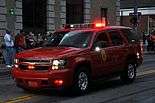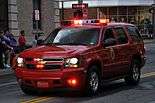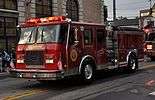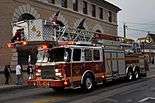Ossining (village), New York
| Ossining, New York | |
|---|---|
| Village | |
|
Main Street in Ossining | |
_highlighted.svg.png) Location of Ossining (village), New York | |
| Coordinates: 41°9′55″N 73°51′24″W / 41.16528°N 73.85667°WCoordinates: 41°9′55″N 73°51′24″W / 41.16528°N 73.85667°W | |
| Country | United States |
| State | New York |
| County | Westchester |
| Area | |
| • Total | 6.3 sq mi (16.4 km2) |
| • Land | 3.2 sq mi (8.3 km2) |
| • Water | 3.1 sq mi (8.1 km2) |
| Elevation | 161 ft (49 m) |
| Population (2010) | |
| • Total | 25,060 |
| • Demonym | Ossinaut |
| Time zone | Eastern (EST) (UTC-5) |
| • Summer (DST) | EDT (UTC-4) |
| ZIP code | 10562 |
| Area code(s) | 914 |
| FIPS code | 36-55530 |
| GNIS feature ID | 0959520 |
| Website | Official website |
Ossining /ˈɒsɪnɪŋ/ is a village in Westchester County, New York, United States. The population was 25,060 at the 2010 census. As a village, it is located in the town of Ossining.
Geography
Ossining borders the eastern shores of the widest part of the Hudson River.
According to the United States Census Bureau, the village has a total area of 6.3 square miles (16.4 km2), of which, 3.2 square miles (8.3 km2) of it is land and 3.1 square miles (8.1 km2) of it (49.37%) is water.
Demographics
| Historical population | |||
|---|---|---|---|
| Census | Pop. | %± | |
| 1860 | 5,345 | — | |
| 1870 | 4,696 | −12.1% | |
| 1880 | 6,578 | 40.1% | |
| 1890 | 9,352 | 42.2% | |
| 1900 | 7,939 | −15.1% | |
| 1910 | 11,480 | 44.6% | |
| 1920 | 10,739 | −6.5% | |
| 1930 | 15,241 | 41.9% | |
| 1940 | 15,996 | 5.0% | |
| 1950 | 16,098 | 0.6% | |
| 1960 | 18,662 | 15.9% | |
| 1970 | 21,659 | 16.1% | |
| 1980 | 20,196 | −6.8% | |
| 1990 | 22,582 | 11.8% | |
| 2000 | 24,010 | 6.3% | |
| 2010 | 25,060 | 4.4% | |
| Est. 2015 | 25,441 | [1] | 1.5% |
As of the 2010 United States Census, there were 25,060 people residing in the village. The racial makeup of the village was 37.1% White, 15.6% Black, 0.1% Native American, 4.2% Asian, <0.1% Pacific Islander, 0.4% from some other race and 1.3% from two or more races. 41.4% were Hispanic or Latino of any race.
As of the census[3] of 2000, there were 24,010 people, 8,227 households, and 5,339 families residing in the village. The population density was 7,464.8 people per square mile (2,879.0/km2). There were 8,515 housing units at an average density of 2,647.4 per square mile (1,021.0/km2). The racial makeup of the village was 51.26% White, 17.87% Black or African American, 0.12% Native American, 3.28% Asian, 0.01% Pacific Islander, 0.44% from other races, and 5.04% from two or more races. Hispanic or Latino of any race were 12.08% of the population.
There were 8,227 households out of which 30.7% had children under the age of 18 living with them, 47.0% were married couples living together, 12.9% had a female householder with no husband present, and 35.1% were non-families. 28.9% of all households were made up of individuals and 9.6% had someone living alone who was 65 years of age or older. The average household size was 2.61 and the average family size was 3.17.
In the village, the population was spread out with 20.7% under the age of 18, 8.3% from 18 to 24, 39.1% from 25 to 44, 20.9% from 45 to 64, and 11.0% who were 65 years of age or older. The median age was 36 years. For every 100 females there were 117.6 males. For every 100 females age 18 and over, there were 119.4 males.
The median income for a household in the village was $52,185, and the median income for a family was $60,179. Males had a median income of $40,412 versus $36,975 for females. The per capita income for the village was $25,036. About 7.6% of families and 10.6% of the population were below the poverty line, including 12.9% of those under age 18 and 8.3% of those age 65 or over.
History
Frederick Philipse bought the area which presently constitutes the Town of Ossining from the Sint Sinck Indians in 1685. The Sint Sinck are members of the Matinecock (Algonquin) tribe, who originally resided in the area of Cow Neck Peninsula on Long Island, New York.[4] His Manor extended from Spuyten Duyvil Creek on the border between present day Manhattan and the Bronx to the Croton River. The last Lord of the Manor, Frederick III, was a Loyalist in the American Revolutionary War who fled to England, so the State of New York confiscated the manor in 1779.
In 1838 Benjamin Brandreth built a manufacturing facility for his Vegetable Universal Pills which became one of the most successful patent medicines in the United States. Brandreth's business became very successful and his firm was at one point the nation's leading proprietary advertiser.[5] Brandreth became President of the village for many years.[6]
Due to the history of the village, a number of Ossining structures are on the National Register of Historic Places, and the downtown shopping area is listed as the Downtown Ossining Historic District.[7] In addition, the Sparta neighborhood has been designated a local historic district. Ossining’s role in New York’s heritage has been recognized by its inclusion, as one of only 14 areas, in an Urban Cultural Park System designed to attract visitors to the State. Also listed on the National Register of Historic Places are the Richard Austin House, Brandreth Pill Factory, First Baptist Church of Ossining, Highland Cottage, St. Paul's Episcopal Church and Rectory, and Washington School.[7]
Name
Until 1901, the village was known as Sing Sing.[8] It changed its name to avoid the stigma of association with Sing Sing Correctional Facility, which is still, by far, Ossining's largest employer.
Transportation
The Ossining train station provides commuter rail service to Grand Central Terminal in New York City or Croton-Harmon and Poughkeepsie via the Metro-North Railroad's Hudson Line. The Bee-Line Bus System provides bus service to Ossining on routes 11, 13, 13B, 14, and 19. NY Waterway also operates a ferry between Ossining and Haverstraw in Rockland County during the rush hours.
Education
Ossining has several public schools and 3 nearby parochial schools. In 2000, Ossining High School was among the United States' highest performing schools.[9]
Ossining has two nearby college campuses. A Westchester Community College campus exists in Ossining; in nearby Briarcliff Manor, there is also a Pace University campus.
Ossining Public Library
The Ossining Public Library, originally chartered in 1893 as the Sing Sing Public Library, serves the residents of the Village and Town of Ossining, and parts of Briarcliff Manor, Yorktown, and New Castle. The current collections of the library include over 110,000 books, 25,000 non-print items, and 300 newspaper and magazine titles. As a charter member of the 38-member Westchester Library System, the Ossining Public Library can also offer its patrons access to the 1 million+ holdings of the other county libraries. An ambitious ($15.8 million) building program was started in 2005 to replace its 1960s-era facility with a new 48,000-square-foot (4,500 m2) building. The new Ossining Public Library opened in March, 2007 and added many new or enhanced services, including over 50 public Internet terminals, a 250-seat theater, an art gallery, and the county's first radio frequency (RFID) circulation system.
The main reading room of Ossining's library is named in honor of longtime Ossining resident, Pulitzer Prize-winning author John Cheever.[10] When Cheever died, the flags on Ossining's public buildings were lowered for 10 days.[10]
Notable buildings
Ossining is known as the home of the Sing Sing Correctional Facility, one of the most famous prisons in New York State.[10]
Ossining is also the home of the worldwide Maryknoll Catholic missions, as well as the site of the Crotonville Institute, the famous General Electric leadership training facility, founded in 1956.
In fiction
In seasons 1–3 of AMC's TV series Mad Men, Ossining is home to lead character Don Draper and his family. It remains the home of his ex-wife, Betty, and their children through much of season 4, until they move to Rye.[11]
In FX's The Shield, transfer to Ossining is offered to an inmate in exchange for testimony, stated as "Safe and sound in Ossining, New York" as opposed to referencing the town's original name of Sing Sing which might have jeopardized the deal.
Notable people
- Edmund March Blunt, navigator and publisher, lived in Ossining.[12]
- Peter Falk, actor, attended Ossining High School.
- John Cheever, writer and winner of the 1979 Pulitzer Prize for Fiction, lived in Ossining from 1961 until his death in 1982.
- Anne Francis, actress, was born in Ossining.
- Raven-Symoné, actress
- Stefan Zweig, the Austrian writer, lived briefly in Ossining and completed his autobiography there in 1941.
- Nick DiPaolo, comedian, known for Tough Crowd
- Robert Byrne (chess player), grandmaster
- Jesse Lee Soffer (actor) born in Ossining; best known as Det Jay Halstead on Chicago Fire
Twin cities
Fire Department vehicle gallery
 Car 2331, a 2013 Chevrolet Tahoe
Car 2331, a 2013 Chevrolet Tahoe Car 2332, a 2011 Chevrolet Tahoe
Car 2332, a 2011 Chevrolet Tahoe Car 2334, a 2008 Chevrolet Tahoe
Car 2334, a 2008 Chevrolet Tahoe Engine 101, a 1993 E-One 1250/750
Engine 101, a 1993 E-One 1250/750 Tower Ladder 42, a 2010 E-One 100 ft.
Tower Ladder 42, a 2010 E-One 100 ft. Rescue 14, a 1995 E-One
Rescue 14, a 1995 E-One Engine 97, a 1937 American LaFrance, department antique
Engine 97, a 1937 American LaFrance, department antique
References
- ↑ "Annual Estimates of the Resident Population for Incorporated Places: April 1, 2010 to July 1, 2015". Retrieved July 2, 2016.
- ↑ "Census of Population and Housing". Census.gov. Retrieved June 4, 2015.
- ↑ "American FactFinder". United States Census Bureau. Retrieved 2008-01-31.
- ↑ "What is Sint Sink?".
- ↑ Atwater, Edward (2004). An Annotated Catalogue of the Edward C. Atwater Collection of American. New York: Boydell & Brewer. p. 118. ISBN 1-58046-098-4.
- ↑ Young, James (1961). The Toadstool Millionaires: A Social History of Patent Medicines in America before Federal Regulation. Princeton: Princeton University Press. ISBN 0-691-04568-2.
- 1 2 National Park Service (2009-03-13). "National Register Information System". National Register of Historic Places. National Park Service.
- ↑ William Joseph Reynolds. "Ossining, a Brief History". villageofossining.org. Retrieved 2010-09-01.
- ↑ MANAGER, OFFICE OF THE VILLAGE. "New to Our Community - Village of Ossining". Retrieved 2014-12-22.
- 1 2 3 Minzesheimer, Bob. "The John Cheever Reading Room". Ossining Public Library.
- ↑ Mad Men ep. 1x09 "Shoot"
- ↑ Samuel Austin Allibone (1859). A critical dictionary of English literature, and British and American authors living and deceased. p. 211. Retrieved 22 May 2013.
External links
| Wikivoyage has a travel guide for Ossining. |
| Wikimedia Commons has media related to Ossining, New York. |
- Official website
- Ossining.com: Ossining, NY's Hometown Web-newspaper
- Ossining Chamber of Commerce
- History, art and photos of Ossining
-
 "Ossining". Encyclopædia Britannica (11th ed.). 1911.
"Ossining". Encyclopædia Britannica (11th ed.). 1911.
.jpg)

